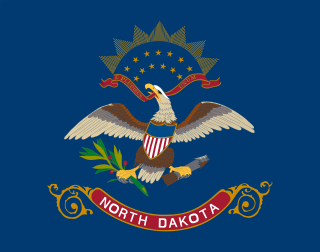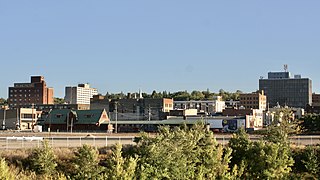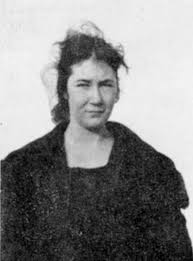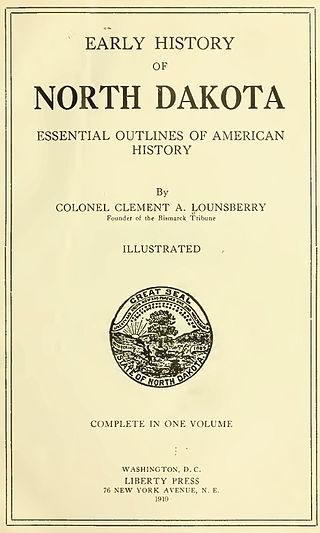Related Research Articles

North Dakota is a landlocked U.S. state in the Upper Midwest, named after the indigenous Dakota Sioux. It is bordered by the Canadian provinces of Saskatchewan and Manitoba to the north and by the U.S. states of Minnesota to the east, South Dakota to the south, and Montana to the west. North Dakota is part of the Great Plains region, characterized by broad prairies, steppe, temperate savanna, badlands, and farmland. North Dakota is the 19th-largest state by area, but with a population of just under 800,000, it is the fourth-least populous and fourth-most sparsely populated. The state capital is Bismarck while the most populous city is Fargo, which accounts for nearly a fifth of the state's population; both cities are among the fastest-growing in the U.S., although half of all residents live in rural areas.

Fargo is the most populous city in the U.S. state of North Dakota and the county seat of Cass County. The population was 125,990 at the 2020 census, which was estimated to have grown to 133,188 in 2023, making it the 218th-most populous city in the United States. Fargo, along with its twin city of Moorhead, Minnesota, form the core of the Fargo–Moorhead metropolitan statistical area, which had a population of 248,591 in 2020.

Minot is a city in and the county seat of Ward County, North Dakota, United States, in the state's north-central region. It is most widely known for the Air Force base approximately 15 miles (24 km) north of the city. With a population of 48,377 at the 2020 census, Minot is the state's fourth-most populous city and a trading center for a large part of northern North Dakota, southwestern Manitoba, and southeastern Saskatchewan. Founded in 1886 during the construction of James J. Hill's Great Northern Railway, Minot is also known as "Magic City", commemorating its remarkable growth in size over a short time.

The Dakotas, also known as simply Dakota, is a collective term for the U.S. states of North Dakota and South Dakota. It has been used historically to describe the Dakota Territory, and is still used for the collective heritage, culture, geography, fauna, sociology, economy, and cuisine of the two states.
The Music of North Dakota has followed general American trends over much of its history, beginning with ragtime and folk music, moving into big band and jazz. With the development of mass media, local artists in North Dakota, as in the rest of the country, saw a rapid loss of opportunity to create, perform, and sell popular music to the regional audience that had previously provided a market. Punk Music is a major genre in the modern youth scene of North Dakota.

KXMC-TV is a television station in Minot, North Dakota, United States, serving as an affiliate of CBS and an owned-and-operated station of The CW Plus. Owned by Nexstar Media Group, the station has studios at the intersection of 2nd Street SE and 18th Avenue SE in Minot, and its transmitter is located near South Prairie.

Prairie Public's television service is a state network of public television signals operated by Prairie Public Broadcasting. It comprises all of the PBS member stations in the U.S. state of North Dakota.

KBMY is a television station in Bismarck, North Dakota, United States, affiliated with ABC and MyNetworkTV. Owned by Forum Communications Company, the station maintains a news bureau and advertising sales office on North 15th Street in Bismarck, and its transmitter is located near St. Anthony, North Dakota.

WDAZ-TV is a television station licensed to Devils Lake, North Dakota, United States, serving the Grand Forks area as an affiliate of ABC. It is owned by the Forum Communications Company, which also owns the Grand Forks Herald. WDAZ-TV's news bureau and advertising sales office are located on South Washington Street in Grand Forks, and its transmitter is located near Dahlen, North Dakota. Despite Devils Lake being WDAZ-TV's city of license, the station maintains no physical presence there.

Hazel Dulcie Miner was a student at a rural Great Plains one-room school, who died while protecting her 10-year-old brother, Emmet, and 8-year-old sister, Myrdith, from the spring blizzard of 1920 in Center, North Dakota.
Chuck Suchy is a folk musician, songwriter, and working farmer from Mandan, North Dakota. Among his albums are Much to Share (1986) and Dancing Dakota (1989) on Flying Fish Records, Dakota Breezes (1993), Same Road Home (1996), Different Line of Time (1999), Evening in Paris (2004), and Unraveling Heart (2008).
Herman, Soren, Ernest, and Adolph Wohlk were four young Ryder, North Dakota brothers who died during a blizzard as they made their way home from school. The three-day blizzard, which lasted from March 15 to March 18, 1920, killed 34 people across the state, including the more famous Hazel Miner.

Carl R. Kositzky was a North Dakota public servant and politician with the Republican Party who served as the North Dakota State Auditor from 1917 to 1920.

JLG Architects is an architecture firm that specializes in urban design, master planning and architectural design for sports/recreation facilities, universities, K-12 schools, aviation facilities, medical centers, and mixed-use/multi-family housing. JLG has offices in Minneapolis, St. Cloud, and Alexandria, Minnesota, and Grand Forks, Bismarck, Minot, Williston, and Fargo, North Dakota, Rapid City and Sioux Falls, South Dakota, and Boston, Massachusetts.

The following works deal with the cultural, political, economic, military, biographical and geologic history of pre-territorial North Dakota, Dakota Territory and the State of North Dakota.

William F. Kurke (1889–1965) was a prolific architect in North Dakota.
The state of North Dakota has improved in its treatment of lesbian, gay, bisexual and transgender residents in the late 1990s and into the 21st Century, when the LGBT community began to openly establish events, organizations and outlets for fellow LGBT residents and allies, and increase in political and community awareness.
Erling Nicolai Rolfsrud was a teacher and writer from North Dakota. His writing particularly covered the history of the state of North Dakota and the Norwegian-American immigrant community.

The Black Building at 114-118 Broadway in Fargo, North Dakota was a "pivotal" historic resource in the Downtown Fargo District, in the listing of that historic district upon the National Register of Historic Places. In 2016 it was also individually listed on the National Register, as its "owners chose to pursue the honor of individual listing for its architecture and for its association with George Mumford Black and his strategies in commerce and communications. Black had the upper floor of the Art Moderne building designed for WDAY (AM) radio and ensured the station signed off each show with “this is WDAY with from the Black Building, Fargo” and he is credited with creating the one-cent sale."
References
- ↑ "Winter in North Dakota". Streams of Life. Retrieved August 9, 2015.[ permanent dead link ]
- ↑ Henke, Warren A. and Albers, Everett G., The Legacy of North Dakota's Country Schools, North Dakota Humanities Council, 1998, p. 262
- ↑ "The Story of Hazel Miner". North Dakota Studies — State Historical Society of North Dakota. Retrieved August 9, 2015.
- ↑ "Hazel Miner". State Historical Society of North Dakota. Retrieved August 9, 2015.